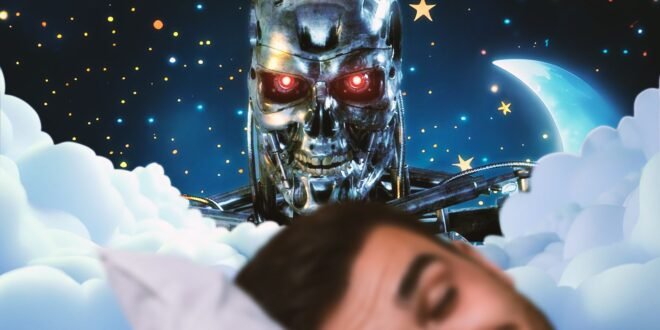
Everybody has had a dream that has always stuck with them, but how many of us have turned those dreams into multi-million dollar film franchises? James Cameron did exactly that with one of his most iconic films, The Terminator, which was released in 1984. Cameron’s movie follows a cybernetic killing machine sent back in time to hunt down a woman who plays an important role in a future war between humans and machines. The movie is a visionary sci-fi thriller that caused Cameron’s career to skyrocket, and it has unique origins straight from Cameron’s subconscious.
The Terminator has become one of the most iconic science-fiction movies in modern history, and birthed a franchise which is ongoing today, including a new arrival on Netflix, Terminator Zero, an animated series that circles around a scientist developing an AI system that could compete with the Terminator franchise’s corporate antagonist, Skynet. The scientist is pursued by a familiar robotic assassin in an eight-episode series that is as visually vibrant and brutal as the original film. Forty years onward, the Terminator franchise is still going strong, and it all began with a seed of an idea that Cameron sketched out from a nightmare.
James Cameron’s ‘Terminator’ Dream Occurred While He Was Sick
In a retrospective interview released in 2021 with the British Film Institute, Cameron recalled the origins of The Terminator. In 1981, while on a trip to Rome, Cameron was ill. Cooped up in a hotel, Cameron experienced a fever dream with some terrifying imagery that immediately made a strong impression. “It was the image of a chrome skeleton emerging from a fire,” Cameron explained to BFI. As soon as he woke up, Cameron began sketching out a concept drawing based on the dream onto a hotel notepad. These drawings were fleshed out over time, and eventually spawned the film itself.
The image of the crawling, skeletal robot would be transposed directly from Cameron’s dream into the climax of the movie, as the T-800’s broken body crawls toward Sarah Connor (Linda Hamilton) before Sarah crushes it in a hydraulic press. Cameron’s fascination with technology informs a longstanding interest in science fiction stories over the course of his career. His movies employ new technologies, and they speculate how the world might respond to technologies in the future. That is, of course, what The Terminator is primarily about: the consequences of technologies that exceed beyond our own capabilities. Perhaps Cameron’s particular interests in the way that technology can be applied to his art subconsciously contorted into the captivating image that spawned this techno-thriller.
‘The Terminator’s Nightmarish Origins Inspired a Sci-Fi Horror Masterpiece
The Terminator spawned an expansive franchise, with five sequels to date, a live-action television series, and the recently released animated series. Most of these properties have leaned into the sci-fi action elements that are teased slightly in the future war sequences of Cameron’s original film. But The Terminator is not an action movie. Much like the trajectory of the Alien films, where Cameron also pivoted the series toward action with Aliens in 1986, The Terminator is structured like a slasher movie folded within a science fiction story. Cameron would go on to deliver one of the most iconic action movies of all time with Terminator 2: Judgment Day, but the original movie is much closer to a straight-up horror movie.
The violence in The Terminator is darker, and Arnold Schwarzenegger plays the character like a classic movie monster. He’s ruthless, cold, unfeeling, and excessively brutal. The sequel is able to feel less horrifying in tone, mainly because having a Terminator on the side of the protagonists shifts the tides and allows the heroes to fight back. In the first film, they’re relatively helpless against the unkillable antagonist, making the chase suspenseful and scary at every turn.
‘The Terminator’ Kicked Off an Impressive Career in Blockbusters for James Cameron
Cameron struggled to make much of an impression with his debut feature, Piranha II: The Spawning. He was so unsatisfied with the experience and the final film that for years he barely even acknowledged it as his own work. But he wouldn’t stay down for long, as his ambitious, visionary work on The Terminator instantly reinvigorated his career. The year after The Terminator, Cameron landed a screenplay credit on the sequel to Sylvester Stallone‘s First Blood, and the following year, he would write and direct Aliens.
After this point, Cameron had proven himself as a visionary director, and essentially had a blank check to make whatever he wanted. His movies would go on to be ingrained in the culture, with Aliens, both of his Terminator films, and Titanic becoming instantly iconic. Many of his larger efforts have become money-printing machines, but don’t think Cameron is losing an ounce of the passion or imagination he’s bringing to his work. Avatar: The Way of Water continued Cameron’s long, impressive track record –– both critically and commercially –– and despite naysayers insisting that the films have little impact in the world of pop culture, the rest of us are already seated and ready for Avatar: Fire and Ash. Cameron has given us some of the most iconic works of science-fiction, and he’s so imaginative that he literally dreamed one of them up in his sleep. The Terminator changed the face of pop-culture, and that image of a robotic skeleton changed Cameron’s career forever.
The Terminator is available to rent on Prime Video in the U.S.
Source link

